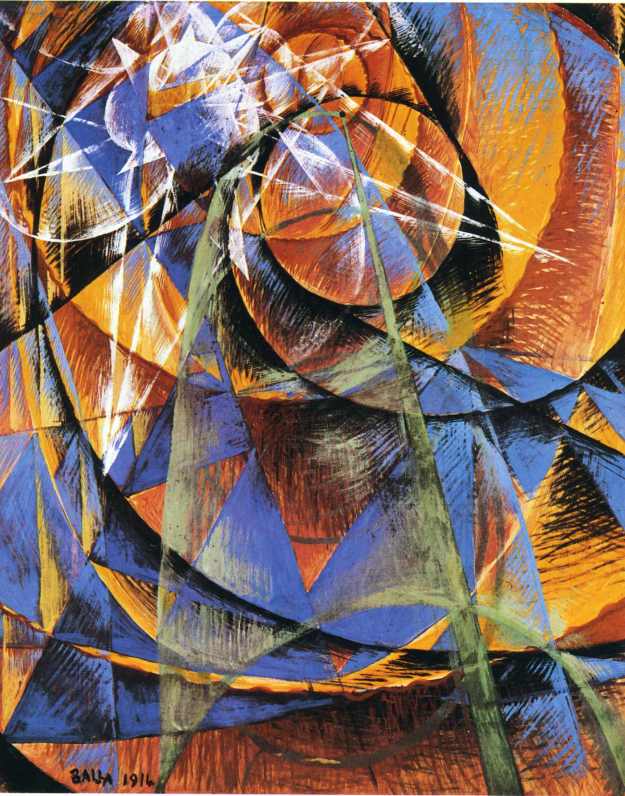Giacomo Balla was an Italian artist and is widely recognised as one of the greatest painters in Futurism. He was born the son of a photographer in 1871 and originally in his early years, studied music. He gave this up after the death of his father and worked in a lithograph shop. In his twenties his growing interest in art took him to Rome where he ultimate developed his famous stark style and unique depiction of motion and light.
My interest in Balla isn’t entirely focused on his depiction of motion in which he uses spirals, reminiscent of the fibonacci spiral, to display motion without constructing any particularly obvious object. This is incredibly interesting however my particular interest is how he depicts light and even sound interacting with or projecting out from this motion.

Velocity of an Automobile
The waiting above, Velocity of an Automobile, is intriguing in the way lines are used to create both the idea of a perspective and a depth but also guide the light in the image. The motion is created through the contrast of the swirls of greys and whites against the stark thick uniform background of lines. It’s interesting to me how Balla deals with light, keeping it very straight and uniform and aligning it with the perspective and structure he creates. I think this structure enables him to create motion by breaking its uniformity.

Planet Mercury Passing in Front of the Sun, 1914
What I find interesting about the painting above, Planet Mercury, is that here Balla directly combines two of his foremost themes, light and motion, but in a brilliant display of colour which he rarely explored in his depiction of automobiles. Through the use of more spirals with widening curves, he generates this idea of radiating light from the central circles. The dark edges of the spirals conveys the motion of the shadow as mercury moves. Here the motion is not directly in the place of the objects which are in fact painted in at the top. Here it is representing by the movement of shadows and the apparent motion of light below. His use of colour is absolutely incredibly giving the display a sense of brilliance and radiance – the warm colours of the sun briefly creating the blue and black shadows of mercury. I also find the white shapes at the top very interesting. To me it almost seems like the lens flare of a camera – Balla’s father was a photographer. As mercury passes over and the shadows recede theres this flare – the sun re-emerging.
The two images above (Abstract Speed – left, and Abstract Speed and Sound -right) are interesting to compare as in both the focus is the speed – the pure motion, yet the one on the right also creates and idea of sound and to do so uses an incredibly interesting colour scheme. A scheme almost garish by Balla’s standards. I think in the one on the right the motion is much more clear and direct, the signature curves interacting with lines of light and spiralling off into tight dark circles which expand as you go from right to left on the painting. I feel like the colour almost obscures the motion in the painting on the right and perhaps this is why Balla tended to avoid being adventurous with colour with the exception of his slightly different take on motion in the painting ‘Planet Mercury Passing in Front of the Sun’. However, clearly he believed the colour to be important in giving the motion a sound. He shows us in so many examples how his motion is the result of curves in a scene constructed of straight lines and light follows the structure along straight lines unless it encounters these curves – no colour require. Just shapes and tones. It makes sense that Balla can add this extra dimension of sound through the introduction of colour. It’s interesting how this links to Kandinsky’s view of colour, shape and sound. For me I feel like the blue against the white is the swishing sound of the wind created by the speed and the red is the speed itself.
In my final piece light is going to be very important in creating perspective and depth and preventing my piece from becoming a mess of colour and shape. Light will allow me to give the painting an obvious direction. To do this I will try to employ some of Balla’s technique, guiding my lines of light along shadow or structure. Should I wish to create motion the sue of curves is an interesting one I may decide to experiment with.

